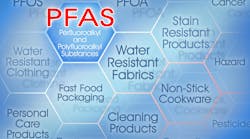On April 19, the EPA issued a final rule that will designate two widely used PFAS chemicals, perfluorooctanoic acid (PFOA) and perfluorooctanesulfonic acid (PFOS), as hazardous substances under the Comprehensive Environmental Response, Compensation, and Liability Act (CERCLA), also known as Superfund.
This action, says the EPA, will help ensure that polluters pay to clean up their contamination.
The agency notes that exposure to per-and polyfluoroalkyl substances (PFAS) has been linked to cancers, impacts to the liver and heart, and immune and developmental damage to infants and children. The EPA notes that this final action is based on significant scientific evidence that these substances, when released into the environment, may present a substantial danger to public health or welfare or the environment. PFOA and PFOS can accumulate and persist in the human body for long periods of time, and evidence from scientific studies demonstrate that exposure to PFOA and PFOS is linked to adverse health effects.
This final action will address PFOA and PFOS contamination by enabling investigation and cleanup of these harmful chemicals and ensuring that leaks, spills, and other releases are reported. This action builds on the recently finalized standards to protect people and communities from PFAS contamination in drinking water.
In addition to the final rule, EPA is issuing a separate CERCLA enforcement discretion policy that makes clear that EPA will focus enforcement on parties who significantly contributed to the release of PFAS chemicals into the environment, including parties that have manufactured PFAS or used PFAS in the manufacturing process, federal facilities, and other industrial parties.
“Designating these chemicals under our Superfund authority will allow EPA to address more contaminated sites, take earlier action, and expedite cleanups, all while ensuring polluters pay for the costs to clean up pollution threatening the health of communities,” said EPA Administrator Michael S. Regan, in a statement.
EPA is taking this step to designate PFOA and PFOS under CERCLA because both chemicals meet the statutory criteria for designation as hazardous substances. Under the rule, entities are required to immediately report releases of PFOA and PFOS that meet or exceed the reportable quantity of one pound within a 24-hour period to the National Response Center, State, Tribal, and local emergency responders. The designation of PFOA and PFOS as hazardous substances under CERCLA enables the agency to use one of its strongest enforcement tools to compel polluters to pay for or conduct investigations and cleanup, rather than taxpayers. Designation is especially important as delay in addressing contamination allows PFOA and PFOS more time to migrate in water and soil, worsening existing contamination.
The final rule also means that federal entities that transfer or sell their property must provide notice about the storage, release, or disposal of PFOA or PFOS on the property and guarantee that contamination has been cleaned up or, if needed, that additional cleanup will occur in the future. It will also lead the Department of Transportation to list and regulate these substances as hazardous materials under the Hazardous Materials Transportation Act.
The American Chemical Council was not in favor of the ruling and told our sister publication, Chemical Processing, that "we strongly oppose this action by EPA and believe this will undermine overall remediation efforts.” See the article for additional comments.
Other Actions Concerning PFAS
In addition to efforts across the government, EPA has taken action under the agency’s PFAS Strategic Roadmap to control PFAS at its sources, hold polluters accountable, ensure science-based decision making, advance environmental justice, and address the impacts on disadvantaged communities. Since launching the Roadmap in 2021, EPA has taken a suite of actions to protect communities from exposure to “forever chemicals” including:
- Established first-ever national legally enforceable drinking water standard for PFAS: In April 2024, EPA finalized National Primary Drinking Water Regulation (NPDWR) for six PFAS which will protect 100 million people from PFAS exposure, prevent tens of thousands of serious illnesses, and save lives. This action complements the Biden-Harris Administration’s commitment to combatting PFAS pollution and delivering clean water.
- Dedicated $9 billion in funding to address PFAS and other emerging contaminants in drinking water: President Biden’s Bipartisan Infrastructure Law secured the largest-ever investment in tackling PFAS pollution in drinking water. An additional $12 billion in funding from the Bipartisan Infrastructure Law supports general drinking water investments, including PFAS treatment. The investments are part of the Justice40 Initiative, which aims to ensure that 40 percent of the overall benefits of certain federal investments flow to disadvantaged communities.
- Guidance on Destroying and Disposing of PFAS: EPA released updated Interim Guidance which outlines the best-available science on techniques and treatments that may be used to destroy or dispose of PFAS and PFAS-containing materials from non-consumer products, including aqueous film-forming foam for firefighting, and highlights innovation and emerging technologies that warrant further evaluation.
- Addressing on-going uses of PFAS: In January 2024 EPA finalized a rule that prevents companies from starting or resuming the manufacture or processing of 329 PFAS; released three methods to better measure PFAS in the environment; and announced the addition of seven PFAS to the list of chemicals covered by the Toxics Release Inventory (TRI), consistent with the Fiscal Year 2020 National Defense Authorization Act.
